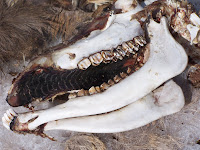TOJs owe a debt of gratitude to a few ectomorphic runners who introduced us to a new world of physical challenges that lead to health and happiness. When I was in high school back in the 60s, it was not cool to do endurance sports. The guys who ran cross country and distances greater than the quarter mile were considered nerds, especially by the macho, muscular mesomorphs who played in the high profile sports of football, basketball, and baseball. Distance running was considered so dreadful that my high school football coach used running a few laps as a punishment.
That perception changed when a series of serendipitous events occurred in the late 60's and early 70s. It started when Bill Bowerman, the legendary University of Oregon track coach, traveled to New Zealand to visit Arthur Lydiard, a milkman and runner who also happened to coach a track club in Auckland, New Zealand. This New Zealand club had some of the best distance runners in the world, like Peter Snell. But more important than teaching Bowerman his secrets for training elite athletes, Lydiard taught him about something more basic which would have a huge impact on him, TOJs and the rest of America -- jogging! Lydiard took Bowerman for a jog, and Bowerman noticed there were joggers of all ages, all over the place in New Zealand.
When Bowerman returned to America six weeks later, feeling much better after having lost ten pounds unneeded weight, he started a jogging club in Eugene. Prior to then, you would rarely see a jogger on the tracks, streets or trails anywhere in North America. It is no coincidence that "Chariots of Fire" was not set in the U.S.
Bowerman also wrote a short book called "Jogging" that became the first running guide and sold a million copies. As the running movement spread, it got another major boost when the cardiologist Kenneth Cooper published "Aerobics," which confirmed the health benefits of running, especially for the heart. Public health officials and doctors had been aware for some time that heart disease was on the rise in America. In the 1950s, doctors who performed post mortems on soldiers killed in the Korean War found an alarmingly high incidence of advanced cardiovascular disease in their young arteries. Emblematic of the times, smoker and President Dwight Eisenhower suffered a life threatening heart attack while in office.
While lots of people were starting to run, it took a couple of elite competitive runners to get the attention of TOJs, then still in their youth. The first was the dramatic emergence in the mid-70's of middle distance phenomenon Steve Prefontaine, who (surprise) was coached by Bill Bowerman. Prefontaine was a cool, good looking guy with the temperamental personality of James Dean in "Rebel Without a Cause." Although he was skinny like all top distance runners, he had long hair and a mustache and looked good on television, which was gaining bigger and bigger audiences with programs like CBS's "Wide World of Sports." Prefontaine had rock star qualities, so when he flipped the hair out of his intense eyes, the girls noticed. Bound for glory, he was fiercely competitive. But like a rock star, he died young in a tragic car accident at the age of 24.
Then running got the ultimate boost when Frank Shorter won the marathon at the 1972 Olympics in Munich, an event that had Americans glued to the TV because of the bloody terrorist attack on the Israeli athletes. An American had not won a marathon in sixty years.
So in cities and suburbs across the land, regular people, including TOJs, who were starting to gain unwanted pounds as they approached middle age, started to run. They discovered that endurance running is very athletic because it requires discipline and dedication on a par with any other sport. And, by running miles themselves, TOJs discovered distance runners are tough and always have been. The skinny nerds, performing at their aerobic limits, endure a level of pain for long periods of time that rival or surpass any pain from a tackle on the twenty yard line or tag at second base.
These once obscure coaches and runners changed American sports forever and gave birth to the 10Ks, marathons, ultra-marathons and triathlons which we enjoy today. Training for these, people discovered they felt better, slept deeper, and thought clearer. Their doctors noticed their blood pressure was lower and blood chemistry improved.
And TOJs kept running, long after youth-obsessed American culture might have them hang up their running shoes, because they found something beyond the adrenaline rush of competition. Something happened while running that was totally unexpected -- an overwhelming sense of peace, calm, bliss, joy, whatever you want to call it. In my case, I found more at oneness with the universe while running a mountain trail than I ever felt in a church.
 March 1. When I started up the trail in early Sunday morning, it was still close to freezing, but my running shoe cracked through a thin layer of frozen crust into a couple inches of red mud. It was a thrilling sensation, a sure sign of Spring.
March 1. When I started up the trail in early Sunday morning, it was still close to freezing, but my running shoe cracked through a thin layer of frozen crust into a couple inches of red mud. It was a thrilling sensation, a sure sign of Spring.  Once when the snow was falling hard, it was like running through a silent white tunnel. It reminded me of a short poem Basho wrote in the 12th century in "Narrow Road to the Deep North":
Once when the snow was falling hard, it was like running through a silent white tunnel. It reminded me of a short poem Basho wrote in the 12th century in "Narrow Road to the Deep North":